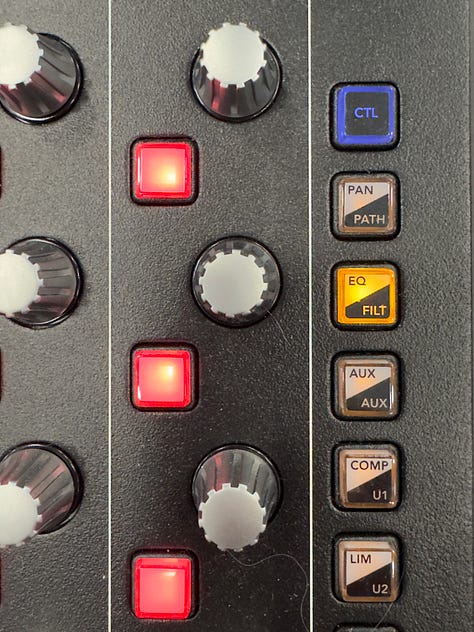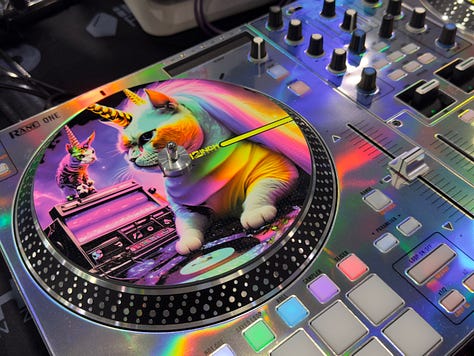The official hardware design review of #namm2024 - Bridging the Digital and the Real
The Rich Musical History of Human Interface Engineering and Instrument Design
AlphaTheta @PioneerDJglobal live presentation from the Steve Jobs Theater with some background about music as a lifestyle and the unique relationship between two companies with undeniable design DNA 🧬.
The NAMM Show, organized by the National Association of Music Merchants (NAMM), has a storied history that dates back to 1901. Originally centered on the piano industry, it evolved to encompass a wide range of musical instruments and technology, reflecting the dynamic nature of the music industry. Notable for its commitment to music education and advocacy, NAMM has consistently emphasized the importance of music in both personal and community development. Throughout its existence, the show has navigated significant historical events, including the Great Depression and World War II, each time emerging as a more vibrant and inclusive event. Today, the NAMM Show is a pivotal gathering in the music industry, renowned for its role in fostering innovation, celebrating music-making, and connecting people across diverse cultures
In the heart of the 2024 NAMMshow, amidst a symphony of sounds and technological marvels, lies a story of design, deeply rooted in the past yet vividly present in our digital age. This year's show was not just a display of musical prowess but a canvas where the art of skeuomorphism painted a picture of how musical instruments have shaped the very essence of human interface engineering.
An Evening with Cosmo Alleycats and Insights from Molly Mahoney
The show kicked off with an electrifying performance by the Cosmo Alleycats. Their music, an intricate tapestry of classic and modern sounds, perfectly mirrored the overarching theme of the NAMMshow. In the audience, Molly Mahoney, known for her expertise in organic growth strategies, shared her insights on the age of AI.






The Evolution of Musical Interfaces Delving into the history of musical instruments and interfaces, human interface designers trace how ancient instruments laid the groundwork for modern interfaces. This exploration begins with the earliest known musical instruments, such as bone flutes and simple drums, which were crafted by early humans thousands of years ago. These rudimentary instruments, though basic in design, were the progenitors of the concept of musical interfaces, embodying the direct and intuitive connection between the musician and their tool.









As civilizations evolved, so too did their musical instruments. The ancient Greeks developed the lyre, a stringed instrument that is a predecessor to the modern guitar, showcasing an early example of design focusing on both aesthetics and playability. In Asia, instruments like the Chinese guqin, a seven-stringed zither, and the Indian sitar, with its complex string arrangement, emerged. These instruments not only provided a richer sonic palette but also required more refined interaction, signifying a step towards more sophisticated musical interfaces.









The Middle Ages and Renaissance periods saw the advent of more complex instruments like the harpsichord and the clavichord. These keyboard instruments laid the foundation for what would become the modern piano, a hallmark of interface design that perfectly balances complexity with user accessibility. The piano’s design, with its intuitive layout of keys, pedals for altering sound, and the ability to produce a wide range of dynamics, exemplifies an interface that is both sophisticated and user-friendly.
In the 19th and early 20th centuries, the industrial revolution and advancements in technology introduced new materials and manufacturing processes, leading to the development of brass and woodwind instruments like the saxophone. These instruments incorporated intricate valve systems and key arrangements, offering musicians enhanced control over their sound and playing techniques.
The advent of electricity brought forth a seismic shift in musical interfaces. The invention of the electric guitar in the 1930s revolutionized music, giving birth to new genres and playing styles. This period also witnessed the emergence of electronic instruments like the theremin and later the Moog synthesizer. These instruments utilized electronic circuits and interfaces to produce sound, offering an entirely new palette of sonic possibilities and challenging traditional notions of what constitutes a musical instrument.









The late 20th and early 21st centuries marked the digital revolution, transforming musical interfaces with the advent of digital synthesizers, MIDI controllers, and computer-based music production software. These tools democratized music creation, allowing for a more inclusive range of creators to participate in musical expression. Digital interfaces provided unprecedented control over sound and opened up new avenues for creativity, blurring the lines between musician, composer, and engineer.
AlphaTheta: A First Look into Pioneer’s new brand transformation, the Omnis-Duo and a new hardware language to steal the show
A standout moment at the show was the introduction of AlphaTheta’s Omnis-Duo DJ controller. This new hardware language was not just about knobs and faders; it represented a paradigm shift in how we interact with digital devices. The Omnis-Duo, with its familiar layout and tactile feedback, was a prime example of how existing hardware languages can create a bridge between the digital and the real, making advanced technology accessible and engaging.









Bathed in the deep, enigmatic navy of a twilight sky, this DJ controller is a symphony of design and function. Each element, from the tactile jog wheels—adorned with halos of celestial blue—to the central display, a window to the soul of the music, whispers of meticulous craftsmanship. These wheels, textured like the grooves of a well-worn vinyl, invite the touch of the artist, promising precision and control as they weave the fabric of soundscapes.
Above, a constellation of knobs stand sentinel, each turn an adjustment in the acoustic realm, fine-tuning the frequencies to harmonize the discordant. Between them, LED meters rise and fall in a visual crescendo, echoing the pulse of the beats. Below, the soft, rubberized buttons and pads await the conductor's touch, each press a command, each sequence a building block of rhythm.
At the heart lies the crossfader—a slender, silken slider—flanked by its channel companions, the artisans of amplitude, the subtle sculptors of sonic layers. With every deliberate slide, they blend and bend the music, a delicate negotiation between the whisper of a verse and the roar of a chorus. Their command is absolute, yet exercised with a lightness akin to a painter's brushstroke, infusing the aural canvas with shades of sound.
Below this central column of control, the tactile pads stand at attention, each a drumhead waiting for the tap of the maestro's fingers—a staccato beat here, a looping melody there, all coming together in a rhythmic gestalt that moves the collective spirit. They are the keystones of creativity, triggering samples and effects, each a punctuation in the poetry of the performance.
And so, this controller, swathed in the hues of an endless dusk, becomes more than a mere instrument; it is a conduit for the narrative of the night. In the hands of the DJ, it tells a tale not with words, but with the language of rhythm and melody, painting stories in the air, ephemeral and powerful, leaving the throng of the dance floor spellbound in its wake.
Tribe XR DJ Academy: A New Frontier in Mixed Reality and Skeuomorphism:
At the NAMM Show 2024, the Tribe XR DJ Academy showcased a groundbreaking approach to real world learning within mixed reality environments, offering a profound look at the fusion of the physical and digital in DJ education. Their virtual reality platform meticulously recreated DJ equipment, providing an immersive learning experience easing the transition for novices from virtual to real-world DJing. This approach not only enhanced the tactile familiarity of physical controls but also leveraged the vast possibilities of digital worlds, impacting the way we perceive, interact and learn.




Meeting BT, a Pioneer of Melodic Trance Music:
An encounter with BT, a luminary in the world of melodic trance music, stood out as a remarkable highlight of the show. Renowned for his pioneering contributions to this genre, BT brought more than just his musical expertise to the table. He engaged in an in-depth discussion focused on the increasingly relevant topic of protecting artists' rights in the rapidly evolving age of artificial intelligence. This conversation was not only enlightening but also critical, as it shed light on the complex interplay between music, cutting-edge technology, and the legal frameworks that struggle to keep pace with these advancements.



BT's insights, drawn from his extensive experience in the music industry, highlighted the challenges and opportunities that modern musicians face in this digital era. He emphasized the importance of understanding and adapting to new technologies while advocating for fair and equitable treatment of artists in the AI-dominated landscape. His perspective offered a unique blend of practical wisdom and forward-thinking, underlining the need for a balanced approach in navigating the future of music creation and distribution. The encounter with BT was not only a meeting with a musical icon but also a deep dive into the critical issues at the heart and soul of artistry in 2024.
Brian put Alana and I in touch with his wife with the possibility of having Alana work with him singing top lines in the near future.
Spotlight on Blackmagicdesign and the John Lennon Tour Bus:
On the John Lennon Tour Bus, Blackmagicdesign's equipment was a game-changer in audio-visual technology. Their interfaces being straightforward, mimicking real-world tools, making them surprisingly enjoyable to use. The visuals are engineered with quality, helping artists see their work clearly. The gear responded quickly, feeling more like interacting with actual instruments than with software. These products designed for real situations, providing the right tools at the right time. This created an immersive experience, making people feel like they were in a high end studio, not just some tour bus.



























Stellar Performances by Stevie Wonder an Lindsey Stirling:
The performances at the event by Stevie Wonder (one of our nicknames for Steve Jobs was Stevie Wonder) and Lindsey Stirling were more than just displays of musical prowess; they represented a profound melding of art and technology, showcasing how digital advancements can elevate artistic expression. DJ QBert, known for his innovative turntable skills, demonstrated how traditional DJing could be transformed with new technology, blending classic techniques with modern digital tools to create a unique sound experience. His performance was a testament to the evolving landscape of music production and performance, where technology is an extension of the artist's creativity.
Stevie Wonder, a legend in his own right, brought his timeless music into a new era, integrating technological elements that added a fresh dimension to his iconic sound. His ability to adapt and evolve with changing times while maintaining the soul of his music spoke volumes about the potential for technology to enhance, rather than overshadow, the artistry in music.
Lindsey Stirling's performance transcended the bounds of a typical musical show, weaving a compelling narrative that struck a chord with the audience, particularly in an era dominated by digital platforms. The show commenced with a poignant reference to Theodore Roosevelt's quote, “It’s not the critic who counts,” setting the tone for a performance that was as much about resilience and artistic integrity as it was about musical talent.
Throughout her show, Stirling's dynamic and emotive style encapsulated the struggle and triumph of creating art in a world where the critic’s voice is omnipresent. Her blend of classical violin techniques with contemporary dance and modern technology showcased how artists today are blending tradition with innovation to make bold statements. This fusion not only highlighted her unique talent but also served as a metaphor for the artist's journey in the digital era – a journey that requires balancing personal artistic vision with public perception and commentary.
Vinyl Virtuosity: DJ QBert's Turntablism Takes Center Stage
At the event, DJ QBert and other turntablists took the stage, showcasing their artistry on the turntables at their finest. Amidst a mesmerizing backdrop of rhythmic beats, they manipulated the turntables with a masterful blend of precision and flair. Their fingers dancing across the equipment, scratching and mixing with an almost supernatural agility.
Each movement a testament to their deep understanding of the craft, seamlessly woven together into complex rhythms and sounds. The crowd was captivated by their performance, which was not just a display of technical skill, but a vivid illustration of the artistry and creativity that turntablism embodies.
Below: DJ T Jr. transformed the turntables into an instrument of musical storytelling, leaving the audience in awe of her compelling soundscapes.
Crafting the Future of Sound: The Story of Teenage Engineering
The design work and hardware language emerging from Teenage Engineering, a relatively small design firm based in Sweden, is nothing short of impressive. Despite their modest size, the company has carved out a significant niche in the world of music production hardware, showcasing an extraordinary flair for innovation and aesthetic appeal. Their products are a testament to the power of minimalist design, blending simplicity with functionality in a way that both captivates and inspires.
What seems to set Teenage Engineering apart is their ability to infuse a playful, yet highly practical sensibility into their hardware without forgetting the basics. Their designs often feature a quirky, retro-futuristic like a vintage Japanese video game that belies the sophisticated technology beneath. This unique visual language not only makes their products instantly recognizable but also approachable, encouraging users to explore and experiment.









The hardware itself is a marvel of engineering. Teenage Engineering manages to pack a surprising amount of punch into compact devices. The build quality is exceptional, with a focus on tactile materials and responsive controls that make using their products a tactile delight. This attention to detail extends to the product experience, which is familiar yet powerful, allowing both beginners and seasoned professionals to achieve their creative vision with ease.
In an industry often dominated by larger corporations, Teenage Engineering's success is a testament to the power of a small design team.
In conclusion, delving deeper into knobs, sliders, and interface elements in the physical realm reveals not only their functional significance but also their profound anthropological role within the history of music interfaces. These tangible elements represent a continuum of human interaction with sound and music, from the earliest instruments requiring manual manipulation to the analog synthesizers of the 20th century where tactile controls shaped electronic melodies. Today, skeuomorphic design principles seamlessly merge these physical interface elements with digital technology, preserving our connection to musical traditions while facilitating sonic exploration. This journey through time underscores the enduring relationship between humans and sound, with physical interface elements acting as cultural artifacts that bridge the past, present, and future of musical expression.




































See you next year at #NAMMshow 2025
Instructions on how to access my design services:
Things I started, enjoy and can help with...
The best way to transform a company’s product line from the inside out is to lock 5 people in a room for three months and tell them not to come out until they’ve redesigned the company. Things I Started: 💌 Apple Webmail 🎁 Apple’s first gift card experience








